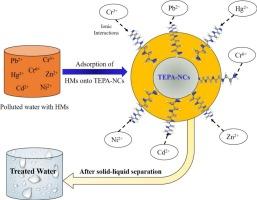通过吸附消除废水中重金属污染物的四乙烯五胺基纳米复合材料合成的最新进展
Q1 Environmental Science
引用次数: 0
摘要
本文探讨了如何制造和使用以四乙撑五胺(TEPA-NCs)为核心的纳米复合材料来吸附污染水体中的重金属(HMs)。本综述对新开发的 TEPA-NCs 的合成方法、结构特征和功能特性,以及与吸附不同类型 HMs 相关的机理进行了深入探讨。由于 TEPA-NCs 表面存在官能团,因此对各种金属离子具有很高的吸附能力。这种吸附剂显示出巨大的重复使用潜力,因为它们可以连续重复使用几个周期,同时保持较高的去除率。等温研究证实,pH 值接近中性时吸附效果较好。相互作用主要是物理性的。等温研究大多符合朗缪尔模型,而动力学研究则符合假二阶模型。作为未来的建议,分析制造这些材料的成本非常重要。本文章由计算机程序翻译,如有差异,请以英文原文为准。

Recent developments in the synthesis of tetraethylenepentamine-based nanocomposites to eliminate heavy metal pollutants from wastewater through adsorption
This article talks about how to make and use nanocomposites with a tetraethylenepentamine (TEPA-NCs) core for adsorption purposes to get heavy metals (HMs) out of polluted water. The present review critically discusses the synthesis methods, structural characteristics, and functional properties of newly developed TEPA-NCs, together with mechanisms associated with the adsorption of different types of HMs. The high adsorption capacity for various metal ions is due to the presence of functional groups on the surface of TEPA-NCs. The adsorbents show great potential for reuse since they can be reused for several consecutive cycles while maintaining high removal. Isothermal studies confirm that adsorption is favored at pH close to neutrality. The interactions are mostly physical in nature. The isothermal studies mostly corresponded to the Langmuir model, while the kinetic studies corresponded to the pseudo-second-order model. As future recommendations, it is important to analyze the costs of manufacturing these materials.
求助全文
通过发布文献求助,成功后即可免费获取论文全文。
去求助
来源期刊

Bioresource Technology Reports
Environmental Science-Environmental Engineering
CiteScore
7.20
自引率
0.00%
发文量
390
审稿时长
28 days
 求助内容:
求助内容: 应助结果提醒方式:
应助结果提醒方式:


